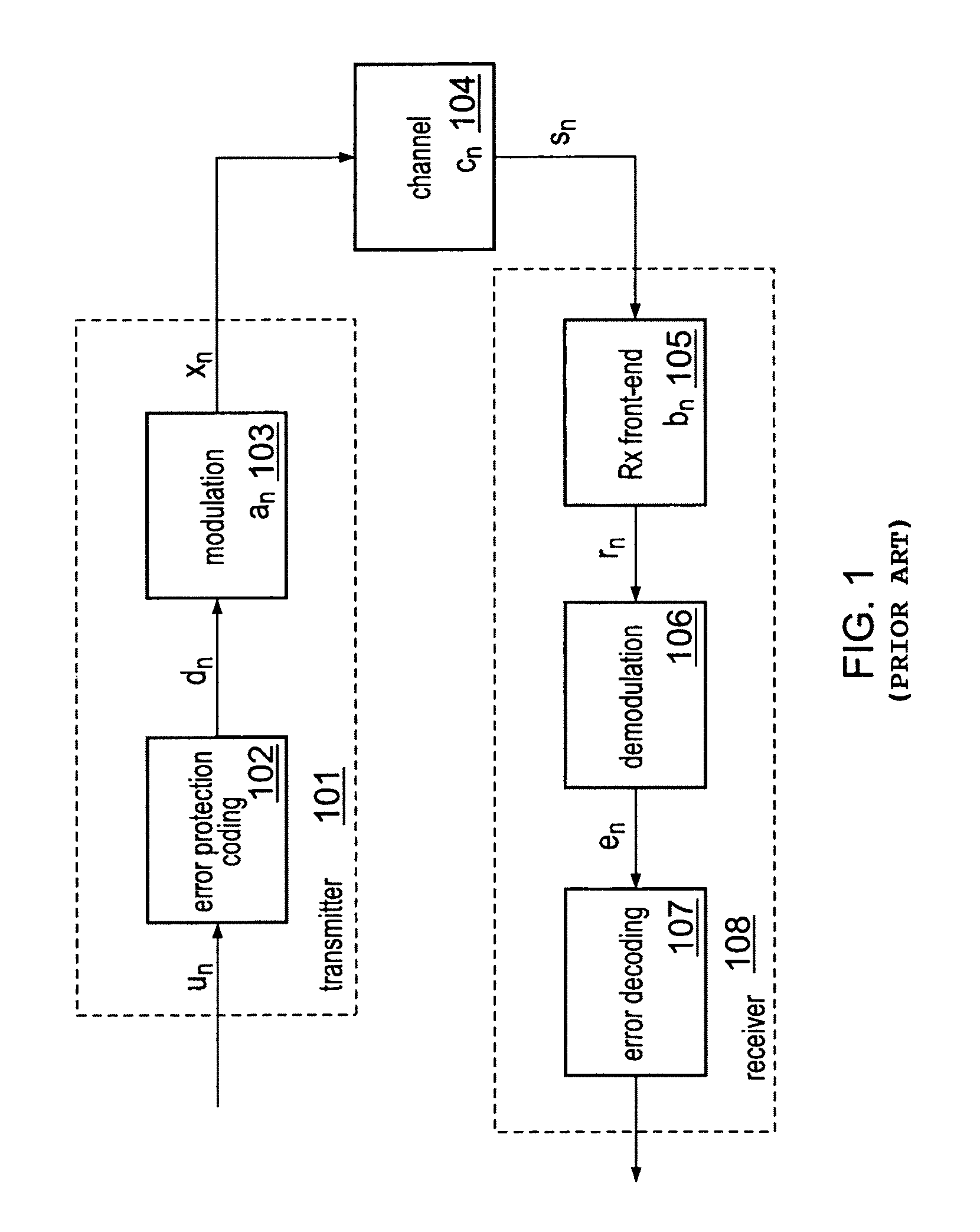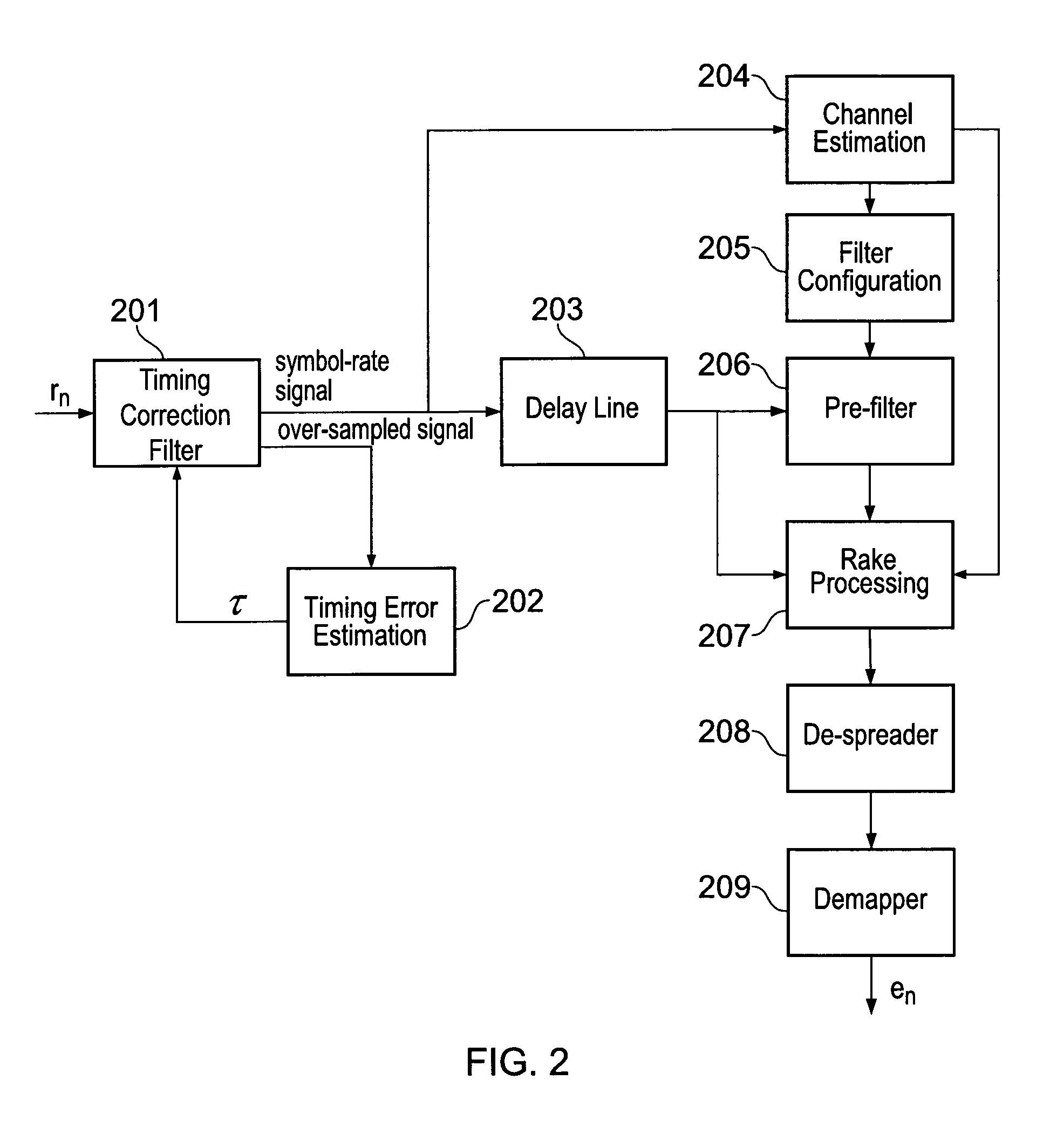[0010]According to one aspect, the invention provides apparatus comprising channel
estimation means for estimating a channel through which a receiver acquires a signal and
Rake receiver means for operating on said signal, wherein the
Rake receiver means is arranged to implement a finger for each tap in the channel estimate (the invention extends to a corresponding method). In this way, the invention can reduce the
processing burden, in that it is not necessary to assess for which channel estimate taps Rake fingers should be allocated.
[0011]According to one aspect, the invention provides apparatus comprising Rake receiver means, pre-filter means, configuring means and evaluation means, wherein the pre-filter means operates on an input to the Rake receiver means, the input represents a signal received through a physical channel, the evaluation means is arranged to evaluate the channel and the configuring means is arranged to re-configure the pre-filter means based on an assessment of the channel after an interval determined with regard to the properties of the channel as determined by the evaluating means (the invention also consists in a corresponding method). In this way, the
processing burden may be adapted to the extant physical conditions, thereby allowing unnecessary calculations to be avoided.
[0012]According to one aspect, the invention provides apparatus comprising Rake receiver means, pre-filter means and configuring means, wherein the pre-filter means operates on an input to the Rake receiver means, the pre-filter means and the Rake receiver means form the basis of an LMMSE receiver and the configuring means is arranged to calculate filter coefficients for use in the pre-filter means and is arranged to make those coefficients symmetrical (the invention also extends to analogous methods of determining filter coefficients for pre-filter means associated with Rake receiver means). Endowing the pre-filter stage of an LMMSE receiver with symmetrical filter coefficients can reduce the number of computations involved in the operation of the pre-filter stage. Moreover, rendering the coefficients symmetrical may not be significantly detrimental to the operation of the LMMSE receiver. In certain embodiments, a set of filter coefficients is calculated for the pre-filter means, e.g. by reference to CIR measurements, and is then rendered symmetric. This rendering may be achieved by averaging calculated coefficients that appear at symmetric positions, for example.
[0013]According to one aspect, the invention provides apparatus comprising pre-filter means and Rake receiver means, which together form the basis of an LMMSE receiver, means for determining filter coefficients for use in the pre-filter means from a signal that is provided for
processing through the pre-filter means and the Rake receiver means and means for delaying the signal that is provided to the pre-filter means in order to reduce time misalignment at the pre-filter means between the signal and the coefficients (the invention also extends to a corresponding method). By reducing or—preferably—eliminating this time mis-alignment, better performance may be obtained from the LMMSE receiver of which the pre-filter means and the Rake receiver means are a part. In certain embodiments, the
delay implemented by the
delay means is variable to account for variation in the duration of the processing required to produce the coefficients (e.g. variation due to variability in filtering used to refine channel estimates from which the coefficients are generated). In certain embodiments, the
delay implemented by the delay means is fixed without significant detriment to the operation of the LMMSE receiver of which the pre-filter means and Rake receiver means are a part.
[0015]According to one aspect, the invention provides a method of quantising soft decisions, the method comprising determining a quantisation step and quantising soft decisions using the step, wherein the size of quantisation step is determined with regard to the distribution of the soft decisions (the invention extends to the corresponding apparatus). In this way, the number of bits, or other quanta, used to represent soft decisions representing a signal can be constrained, potentially leading to a reduction in data storage requirements. The step size may or may not be based on the mean of a group of soft decisions. The step size may be based on a variance or standard deviation of a group of soft decisions. Typically, the step size is driven so that it increases as the distribution increases and decreases as the distribution decreases.
 Login to View More
Login to View More  Login to View More
Login to View More 


